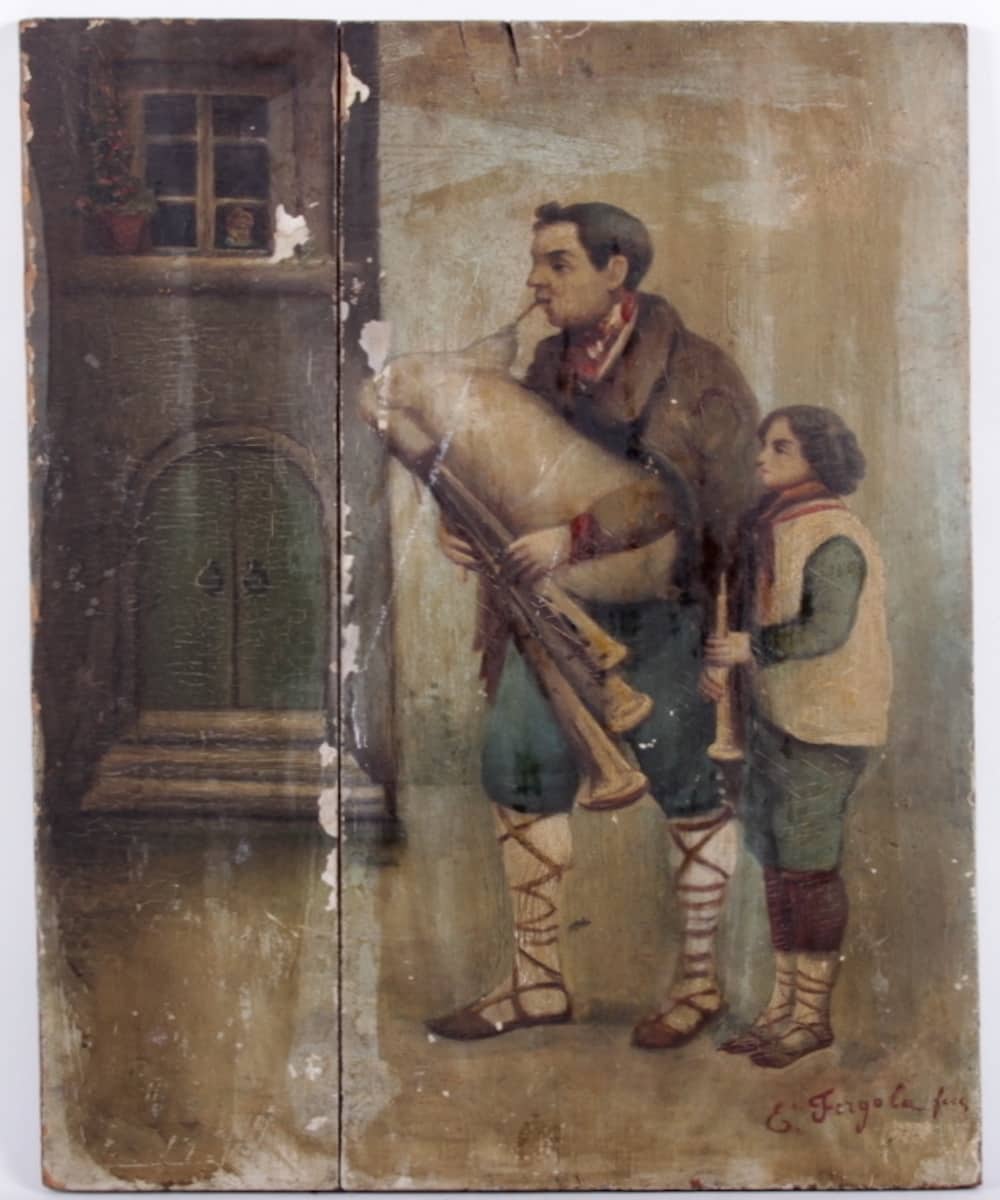The holiday season is coming, don't be caught unprepared! Our Grinch-proof vademecum reveals the essentials about Christmas Italian style.
The typical ingredients of Christmas movies are all there: festive markets, the scent of ginger and cinnamon in the cold December air, Winter Wonderland lights and festoons and the frantic rush for presents.
Yet, this is only part of Christmas iconography in Italy, where traditions are ancient and so deeply rooted to be real cultural and identity elements transcending the festivities.
Discover the curiosities and rituals you still don't know about the most wonderful time of the year in your favourite country.

5. Zampognari: Italy’s Christmas tradition of shepherd musicians

Zampognari
A very peculiar sound, loud and melodic, anticipates the arrival of Christmas. You can hear it in squares and streets decked out in lights and decorations, coming from alleys, churches and even from some homes.
Zampognari, the local bagpipers, are an emblem of the festive season, a Christmas icon just like the tree and the presepe. It’s difficult to find a representation of the Nativity without a couple of pipers.
By the way, what are zampognari in Italy? The name suggests a "zampogna player", a typical wind instrument consisting of a sheepskin bag and a reed set. Its origins are so ancient that the line between sacred and profane, myth and history, is now almost blurred.
A descendant of the "imperial" utriculus, an instrument dear to Nero and used by shepherds to gather the flocks, legend links it to Pan, the god protector of the countryside and pastures. During the Middle Ages, it spread throughout Europe, diversifying into various territorial types, like the Scottish bagpipe or the French musette.
Anyway, what does the bagpipe have to do with Christmas? To find out, we must once again take a step back in time. We mentioned Pan: well, this deity was associated with the winter solstice and the celebrations for the Sun rebirth culminating at the end of December.
The advent of Christianity overlapped Christmas on these celebrations, so the "pagan" zampogna slowly became a symbol of the new festivity.
The consecration took place in 18th-century Naples. In 1754, Bishop Alfonso Maria de' Liguori signed one of Italy's most popular Christmas songs, Tu scendi dalle stelle. The melody soon became popular, sung in the streets by the lazzaroni (beggars) to the sound of bagpipes.
The tradition of gli zampognari is renewed year after year, carried on with pride by musicians who are the custodians of an old but pretty much alive art.
4. La Befana: origins and meaning behind a “sweet” tradition

La Befana
The ritual has been the same for centuries. On the evening of 5 January, empty stockings are hung by the fireplace or at the foot of the bed. A shabby-looking old woman who wanders around on a broomstick will fill them during the night: candies and chocolates for those on the good list and lumps of coal for the naughty ones.
Every child in Italy knows that the arrival of La Befana coincides with the last day of the Christmas holidays and the imminent resumption of school activities. Although it is a much-loved celebration for the little ones, it brings some inevitable melancholy, too.
After all, as the popular saying goes, "The Epiphany sweeps away all the festivities". However, waiting for the arrival of la Befana is undoubtedly one of the most magical childhood appointments. Where does this festa come from?
The tradition is archaic: its origins are pagan, and only at a later stage it was incorporated into Christian culture and included in the Epiphany celebrations. A figure similar to La Befana already existed in the 6th century BC. It used to represent the changing of the seasons, the old giving way to the new.
The legend that links this good hag to the Christian imagination dates back to the 12th century. It tells of the woman who refused to give directions to the Wise Men on their way to Bethlehem and how, repentant, she set off in search of baby Jesus with a bag full of presents for the children she would encounter along the way.
As many generations of kids can testify, the old lady generously continues to distribute her gifts for one night a year.
3. Il presepe: what it is and where it was born

Il Presepe
When it comes to traditions, we cannot avoid mentioning what many enthusiasts consider an authentic cult in its own right. Il presepe is a staple of Italian Christmas and a source of great fascination even for those who don't believe.
Normally, Italians set it up on 8 December. It can be basic, limited to the Holy Family, or very complex and articulated, full of characters (shepherds, craftsmen and musicians) and even scenic tricks (light effects and automated mechanisms).
The first-ever was in Greccio, a small village near Rieti. Here, in 1223 Saint Francis realized an essential reproduction of the nativity scene consisting of a manger, an ox and a donkey.
St Francis' portrayal brought to life one of the most sacred events in Christianity for the first time. It was so successful that the first créche figurines and scenery began to pop up in churches and homes. From Greccio, the practice of the presepe spread to the rest of Italy and gradually became a tradition.
In the 15th century, it took root in Naples, where it became an art form and a characteristic element of the city's culture (come and see Via San Gregorio Armeno to understand what we are talking about). During the 1700s, a period of great fortune for crib art, it was also a source of pride for noble families, who competed to have the most original and sumptuous installation.
2. No meat on Christmas Eve and lentils on January 1

Christmas Eve dinner
On the evening of 24 December, Italians gather around dinner tables to celebrate Christmas with their friends and family. And while each region has its singularities regarding the most typical dishes to serve, there is one thing everyone agrees on: on Christmas Eve, they eat fish (or, at least, not meat).
The reason is not in a spiritual precept. Indeed, as stipulated in the 1966 Apostolic Constitution Paenitemini, meat consumption is allowed on the day before a religious celebration. Today, the custom of bringing fish dishes to the table is mostly a popular inheritance.
On the other hand, lentils on New Year's Eve are essential for luck and prosperity in the months to come. Is it really a lucky legume? According to legend, eating lentils on New Year's Eve would ensure money and good fortune.
The use seems to date back to ancient Rome. At that time, on 1 March (the last day of the year), people used to give a pouch (the scarsella) full of lentils as a gift, wishing that they would turn into coins during the New Year.
1. A Christmas compilation: where to find the best traditions

Mercatini di Natale
Each region has its particularities and traditions renewed from year to year, ranging from cuisine to popular and religious rituals. Some are surprisingly curious.
In Veneto, for example, Santa Lucia brings gifts to children on the night between 12 and 13 December. The feast is awaited with particular affection in Verona. Here, the central Piazza Bra hosts the "banti de Santa Lussia", a fair of typical handmade products, food and other specialities.
The day of Santa Lucia is a top-rated event also in Sicily. Especially in Palermo, Arancina day is celebrated on 13 December. What does a milestone of Italian street food have to do with the Syracusan martyr?
The tradition has its genesis in the terrible famine that afflicted the city in the 17th century. It is said that a ship loaded with grain miraculously appeared precisely on 13 December 1646. Since then, the people of Palermo have given up bread and pasta for one day in favour of arancini, a delicious rice snack.
Getting back to a more classic theme, the characteristic Christmas markets in Trentino Alto Adige are a must during the festive season. You will find super atmospheric mercatini in Bolzano, Trento and Merano, but many others are scattered in the regions: find them all.
In the Marche region, a unique and enchanting ambience descends on the town of Candelara every year: the lights go out to make way for the warm glow of the thousands of candles that brighten the annual Christmas market, giving it an extraordinary timeless aura.
In Gorfignano, Tuscany, Christmas Eve is illuminated by the fires of the Natalicci, high bonfires made from interweaving branches gathered from nearby woodlands. According to lore, it is possible to make predictions on the new year by looking at how the pyres burn out.
A fascinating ritual takes place in the medieval village of Oratino, in Molise. A 15-metre-long candle made of dry branches and reeds is carried in procession to the Church of Santa Maria Assunta in Cielo and burned on Christmas Eve. The morning after, the inhabitants gather in the square to collect the large bonfire ashes as a sign of good omen.
About the author
Written on 03/12/2021



Lorena Calise
Are you sure you know everything about the most classic Italian Christmas traditions? We bet you've missed something. Read on to the end for the most curious ones.